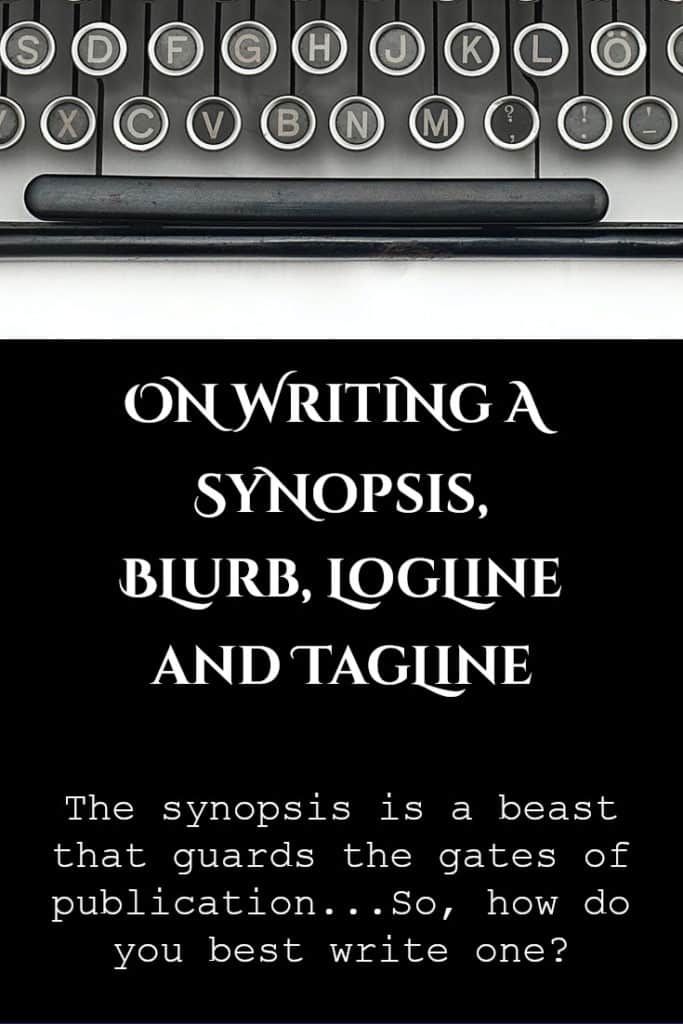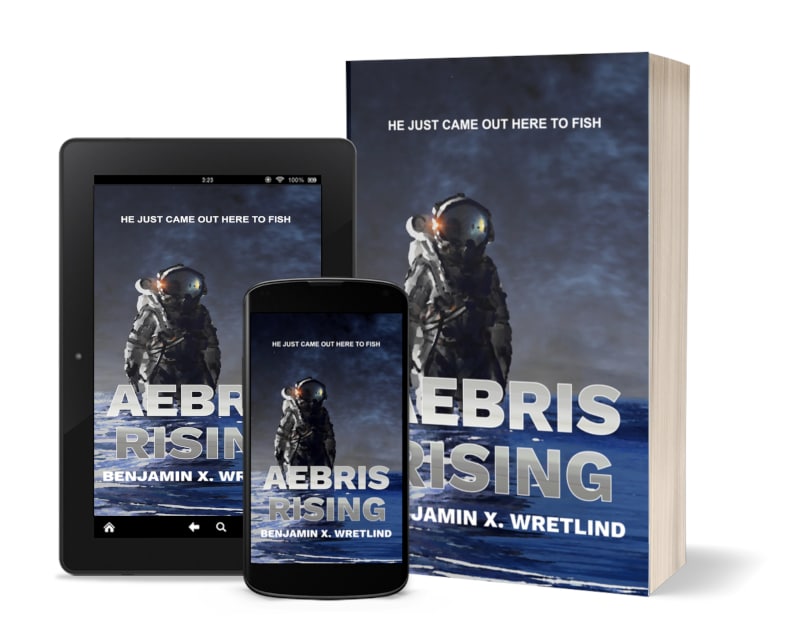On Writing a Synopsis, Blurb, Logline and Tagline

It’s the same for every writer, I suppose: the synopsis is a beast that guards the gates of publication, one that rears its ugly head right after finishing a 100,000-word novel. So, how do you best write one?
Sure, you can write100,000 words (or much, much more), but can you condense all that into a synopsis for an agent or (worse, in my opinion) the blurb on the back of the book that doesn’t give away any spoilers?
Nope, I’m not a fan of them, but writing a novel is not the only place where the synopsis is required. There’s the blurb which we just mentioned. Then screenwriters have the glorious job of writing the logline for a script or a tagline that condenses all your months or years of hard work into three or four words.
Maybe five, if you must.
Two would be best.
I admit that I struggle with the synopsis, blurb, logline and taglines. But I did find a way that helped me write them.
I call it reduction.
Way back when, I published a post on how I outline material. This outline is not static, meaning I do not write it once and forget about it. Instead, I update certain parts as I go. After all, if you’re like most writers, the story can get away from you, go its own direction, forge its own paths.
Within my outline for any novel or novella, there are three Very Important Columns. They are:
- Chapter Synopsis – this is what it says (and the first thing I write)
- Subpart Synopsis – this is also what it says and it breaks down or supports the Chapter Synopsis
- Side Bar Information – writer’s notes; not for readers, for you
The synopses in these cases are made up of nothing more than a simple sentence or two about what I intend to write about. For example, a subpart of Chapter 2 in my upcoming novel Out of Due Season: The First Transit states simply:
The divers suit up and STUART runs through the checklist with them, explaining how the search will take place. He takes ZACHARY to the side and attempts to calm his nerves.
Kind of boring, but that’s not for the reader. If that’s what I end up writing, great. If I change things (for example, making the character ALLEN talk to ZACHARY), then I’ll adjust what I wrote.
This is the important piece to writing the synopsis at the end: getting the details correct after the text is written. Don’t just write it and leave it even if your story changes. Really say what happened after you’re done.
When the first few drafts of the novel are done and you have a bunch of subpart synopses, you can then begin the reduction process.
First: Reduce all the chapter subparts into 1 or 2 sentences that summarize the entire chapter
Here’s where I started (this is Chapter 2 only):
- The divers suit up and STUART runs through the checklist with them, explaining how the search will take place. He takes ZACHARY to the side and attempts to calm his nerves.
- As the dive teams head out to the middle of the lake, TALBERT, who was asked to do research on the body recovered the day before, founds out HENRY BACKMON was listed as a missing persons from Iowa some six months ago.
- In the water with STUART and ZACHARY, who discover more bodies. ZACHARY reacts poorly and they return to the zodiac.
- A call comes in from Seattle that help is on the way, but it may take longer than anyone would like.
- While the second dive team is in the water, ZACHARY attempts to go through the numbers in his head and dehumanize the bodies that will be recovered at a later time. STUART and ZACHARY dive again, this time finding the hatch.
Here’s where I ended up:
While marking the body locations for retrieval, two members of the recovery team–STUART TAYLOR a seasoned veteran and ZACHARY MILLER, a rookie–discover something metal on the lakebed. Meanwhile, ALLEN and CLARKE attempt to identify the first body pulled from the water while waiting for help to arrive from Seattle.
Next, summarize all the chapters into 1 or 2 sentences that relate to the events of the entire part or Act (if you’re working with parts or Acts, of course)
Here’s where I started (there are 6 chapters in Part I):
- In a lake in northwestern Washington, a body is discovered floating. A recovery team, comprised of divers and other survivalists and led by CHRISTOPHER ALLEN and BRADLEY CLARKE, is sent to retrieve the body, but when they do, they discover more. Eventually, 312 bodies are recovered from the lake, each with a note pinned to them which implies they were part of a religious cult known as the Circle of Light.
- While marking the body locations for retrieval, two members of the recovery team–STUART TAYLOR a seasoned veteran and ZACHARY MILLER, a rookie–discover something metal on the lakebed.
- ALLEN and CLARKE, with the assistance of DAVE TALBERT, read through some of the notes they have recovered and notice striking similarities to other mass suicides in history. ZACHARY and STUART report what they found and are asked to take a few pictures of the hatch on the next dive. Meantime, the government sends their own investigative team for relief.
- ZACHARY considers the dead in the water and drifts off to sleep. STUART then imparts his fatherly wisdom on ZACHARY when he wakes up. The two have formed a close bond, especially since ZACHARY’s own parents were killed years ago.
- While the recovery team continues to mark the location of the bodies, TALBERT investigates some of the names pulled from the notes. STUART and ZACHARY take another look at the hatch and discover the dogs move a little, indicating it could be opened. That evening, the recovery team is informed they are no longer needed.
- ZACHARY finds out that his sister, CLAIRE, was one of the bodies in the water. He is distraught about losing the last member of his family, but when he returns to his apartment in Tacoma, he receives a time-delayed e-mail from CLAIRE which suggests she may still be alive.
Here’s where I ended up:
On a June afternoon, a body is discovered floating in a remote lake in northwestern Washington. Led by CHRISTOPHER ALLEN (48) and BRADLEY CLARKE (46), a recovery team is sent to retrieve the body, but when they do, many more bodies are discovered under the water. Eventually, 312 victims are recovered, each with a note pinned to them which implies they were part of a previously unknown religious cult known as the Circle of Light. Two of the dive team members, ZACHARY MILLER (25) and STUART TAYLOR (59), uncover what they believe may be a hatch. ZACHARY discovers his sister was listed as one of the deceased.
You might notice that quite a bit of information is missing. In the world of synopsis writing, you really don’t have much room. You have to a) capture the attention of the agent, b) tell just enough to explain what happened, and c) adhere to certain conventions as you see above with regard to the introduction of characters and their ages…in 1-2 pages or 500 words.
In the end, you should have 1 paragraph for each part (or Act) that you can use to build the synopsis for your query package. You can also use that synopsis for everything else: the blurb, the logline, and the tagline.
The Blurb
In the synopsis, you really shouldn’t leave anything important out, to include the ending. However, in the blurb–or the back cover copy–it’s important you reveal just enough to capture a potential reader’s interest.
So here is that first paragraph of the synopsis as it was rewritten for the back cover of Out of Due Season: The First Transit:
On a June afternoon, a body is discovered floating in a remote lake in northwestern Washington. When a recovery team attempts to retrieve it, they make a shocking discovery: 311 other bodies lie under the water, all members of a previously unknown religious cult. However, what appears to be a tragedy of immense proportions is only the beginning.
Quite different.
The Logline
The next step in reduction is to take your blurb and make a logline. Loglines are typically used in the world of screenwriting, but they are also very helpful with novels. Think about a logline as your 5-second elevator speech (which is much less than the 30-second elevator speech you’ve heard about).
There is a formula I found once that helps in writing a logline:
When [INCITING INCIDENT] happens, [OUR PROTAGONIST] decides [TO DO ACTION] against [ANTAGONIST].
For the most part, this works. You’ll have to play with your story to make it fit, however, especially if your antagonist is an event or series of events. In the case of Out of Due Season: The First Transit, the logline I ended up writing (again, reduced from my outline down to the synopsis down to the blurb) was:
When questions arise around a seemingly tragic event, a small group of relatives and friends of the victims band together to learn the truth: something epic is about to happen in a remote lake in northwestern Washington, and the genesis of a new world is underway.
The Tagline
Now that all of that stuff is out of the way, the final step in reduction is to write something that immediately captures a reader’s attention: the tagline.
Oxford defines a tagline as “a catchphrase or slogan, especially as used in advertising.” Think about what you see on movie posters. Here are some of my favorites (see if you can guess the movie):
“They were 7… and they fought like 700.”
“Who you gonna call?”
“Work sucks.”
“You’ll never go in the water again.”
“Man is the warmest place to hide.”
If you can’t guess the movies those taglines belong to, check out this article to give you some ideas.
(As an aside, taglines can help you write pitches that can help you sell your book or movie. For Alien, Ridley Scott famously sat in a room opposite execs and said “It’s JAWS in space.” while James Cameron sold Aliens by writing “Alien$” on a chalk board.)
In the case of Out of Due Season: The First Transit, I focused on the last phrase of my logline: “…the genesis of a new world is underway” and came up with the following:
In the beginning…
I think it fits since a) it’s short and b) it tells readers that the novel is the first in a series.


















